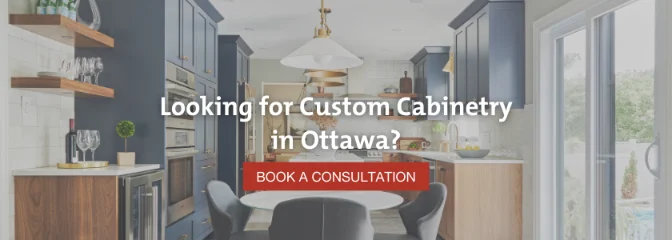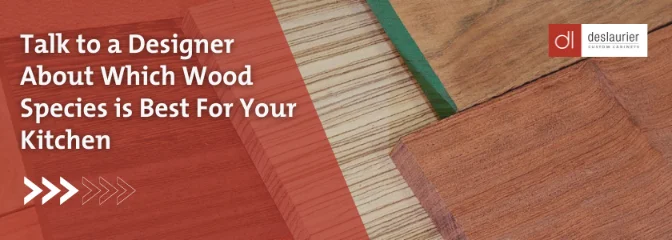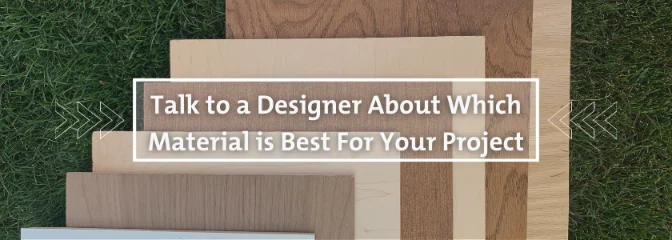1/08/2023 • Blog, Product Reviews, Custom Cabinets
Pros & Cons of 15 Popular Kitchen Cabinet Materials
Estimated Read Time: 10 Minutes
When looking for new kitchen cabinets, the number of wood species to choose from can seem overwhelming. Not to mention sifting through the man-made cabinet materials available.
We’re here to help!
At Deslaurier, for over 40 years we’ve specialized in manufacturing custom cabinets. In that time, we’ve completed thousands of projects and worked extensively with clients to select the best material for their kitchen cabinets, whether that be a wood species or an alternative product.
In this article, we’ll take a look at the pros and cons of 15 popular wood species and materials used for kitchen cabinets, from birch to thermofoil and everywhere in between!
Let’s get to it!
|
Table of Contents |
Birch
Pros:
Price: Birchwood is one of the more affordable wood species due to how highly accessible and populous it is in North America. For that reason, birch will typically be near the bottom of the pricing scale for solid wood cabinets.
Strength: Birch is a strong and durable wood, great for kitchen cabinets in high-traffic areas, and carries a 1260 rating on the Janka hardness scale, a measurement that determines a wood sample’s resistance to denting or wear.
Paint-grade surface. Birch is known as a paint-grade wood thanks to its low-key grain and smooth, uniform surface. If you’re going with natural wood for your painted cabinets, birch is about as good as it gets.
Cons:
A stained finish can be blotchy: birch is a slightly porous wood species. When it comes to using a dark stain on birch, the cabinet doors may absorb the stain at varying speeds which can cause a “blotchiness” effect.
Joints are susceptible to cracks: As natural products, every solid hardwood will expand and contract with changes in temperatures or humidity – referred to as “breathing” – which can result in movement along the joints of a 5-piece door.
Maple
Pros:
Appearance: Maple’s grain pattern is generally quite straight, with some subtle waves and curls mixed in, while its colour is rooted in a gentle white with reddish-brown hues.
Paint-grade surface: Maple shares plenty of similarities with birch, like a smooth surface and similar grain patterning.
Less “blotchiness”: Compared to birch, however, maple is a less porous wood. You shouldn’t worry about any pronounced blotchiness when a dark stain adheres to maple cabinets.
Strength: Maple is a very strong and durable solid wood and carries a 1450 Janka score.
Cons:
Susceptible to cracks: Like every solid hardwood material, maple cabinets will expand and contract with changes in temperatures or humidity that can result in movement.
(Red) Oak
Pros:
Design flexibility: The beauty of red oak and its prominent grain is that it can be adorned with anything from a clear coat finish to a dark stain. While oak often has the connotation of being a more traditional-looking cabinet wood, there are plenty of ways you can put a modern flair on oak cabinets!
Strength: Oak is a strong and durable solid wood and carries a 1290 Janka score.
Value: Oak is a fairly affordable option as compared to other solid wood kitchen cabinet materials, roughly in the vicinity of birch and maple.
Cons:
Textured Surface: Red oak is known for its prominent, raised grain pattern which results in a more textured surface. This can be a detriment if you prefer a smoother cabinet in your kitchen.
Susceptible to joint cracks.
Rift-Cut White Oak
Pros:
Design Appeal: The allure of white oak has grown in popularity over recent years. From hardwood flooring to kitchen cabinets, white oak is a hot commodity and one of the best ways to add a modern touch to oak cabinets.
Durability: Not only is white oak a strong species with a Janka rating of 1360, but it’s also rot-resistant, making it a highly durable wood overall.
Cons:
Price: White oak is a high-demand material, making it one of the most expensive cabinet materials on the market and roughly 40% more than its red-oak counterpart.
Susceptible to joint cracks.
Cherry
Pros:
Appearance: Noted for its rich, dark, reddish-brown colour and smooth, closed-grain pattern, cherry is one of the most luxurious woods you can find for your kitchen cabinets.
Natural aging process: Starting almost as light or golden pink, cherry gradually gains deep, alluring reddish-brown hues as it is exposed to oxidation and natural lighting over time.
Light stain: Since the wood naturally gets darker with time, it doesn’t require a deep, heavy stain like some other woods might.
Cons:
Price: Cherry is considered a luxurious cabinet material and as such is priced higher than that of maple, birch, or red oak.
Susceptible to joint cracks.
Walnut
Pros:
Stunning natural appearance: Noted for its significant colour and strong, typically straight grain variation, walnut can range anywhere from a light brown to a deep, dark chocolate hue.
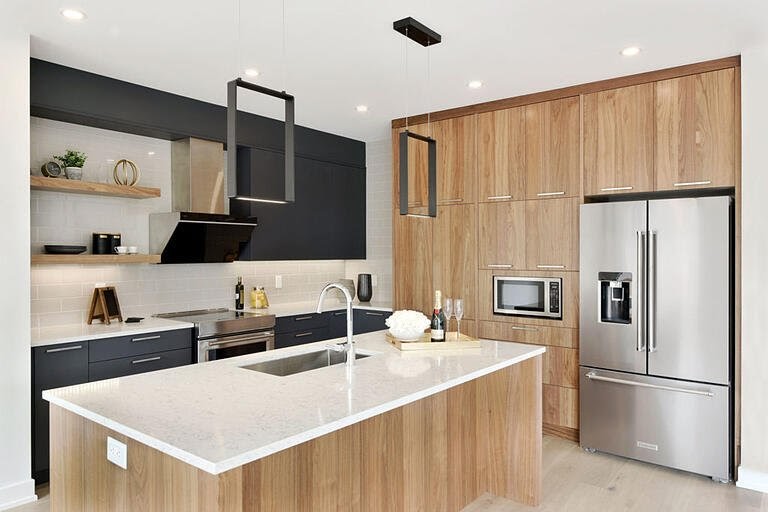
Unique aging process: Walnut wood also has a unique aging process, however, it’s different from cherry. With time, the dark brown colour of walnut will naturally begin to lighten.
Less stain needed: The qualities of walnut lend themself beautifully to light stains and clear coat finishes. When finished with a clear top coat, walnut portrays a very rich and velvety sheen that accentuates its strong grain pattern.
Cons:
Expensive: Walnut is a high-end wood species that typically sits above cherry, near the top of the cabinet material pricing scale with white oak.
Susceptible to joint cracks.
Rustic Alder
Pros:
Rustic farmhouse appearance: As its name suggests, rustic alder leans towards a more rustic aesthetic, prized for having plenty of large knots. The look and amount of knots will fluctuate from door to door or slab to slab, which gives alder a very defined visual appeal that is great for cottagey, rustic, or farmhouse-style kitchens.
Cons:
A “soft” hardwood: Rustic Alder is considered one of the “softest” hardwoods available and only carries a 600 rating on the Janka scale.
Susceptible to joint cracks.
Wood Veneer
Pros:
Natural wood appearance: Wood veneer is actually real wood! To create wood veneer, a thin sheet of real hardwood adheres to an underlying substrate like particleboard or plywood. This means the wood veneer provides an authentic natural wood appearance.
Material flexibility: Wood veneer actually offers a larger variety of wood species to choose from than solid wood. Wood veneer allows you to utilize exotic woods that are harder to source, such as bamboo and mahogany, as well as more expensive woods like walnut and white oak.
Price: As we mentioned, wood veneer is much cheaper (and lighter) than solid wood. In fact, Simply swapping the centre panel with a wood veneer, with the stiles and rails remaining solid wood, can save roughly $50 per cabinet door!
Available finishes: Since the surface of wood veneer doors is made from real materials, wood veneer can be finished with stains and paints, just like solid wood. Wood veneer doors can actually be colour and stain matched.
Cons:
Flat Surface only: The main aesthetic limitation of wood veneer cabinets is that the sheets cannot be applied to any 3-dimensionally designed cabinet door styles such as raised centre panels. Further, if you want a 5-piece cabinet door style, the frame will have to be made using solid wood.
Durability: Wood veneer is not as strong or durable as solid wood. Compared to solid wood, wood veneer is more vulnerable to scuffs and scratches.
Water damage: If water gets past the veneer it can spread within the particle board substrate, causing the door to expand. Excessive moisture or water damage can also cause the veneer sheet to loosen or “bubble” from its base.
Medium-Density Fibreboard (MDF)
Pros:
Paint quality: MDF is manufactured by breaking down soft and hardwood residuals into wood fibres and compacting them with wax and resins. This makes it free of any knots, blemishes, or tactile wood grain that is commonplace for natural woods. Its smooth surface offers a pristine canvas for the paint to adhere to.
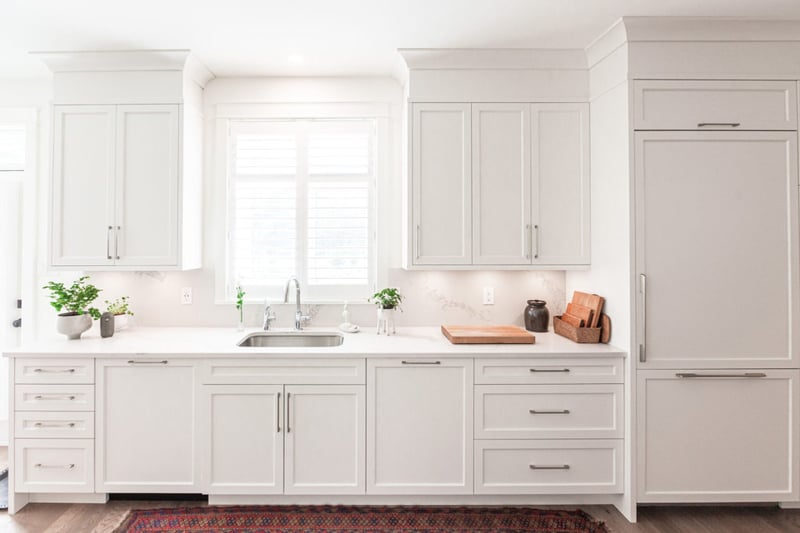
Not as susceptible to cracks: Since it is not solid wood, MDF is much less susceptible to breathing. This means MDF doors are not as likely to expand and contract due to changes in temperature or humidity and the painted finish is far more stable.
Value: While the quality painted finish increases costs, the MDF material itself is affordable.
Cons:
Water damage: If exposed to a pronounced amount of liquid or moisture, MDF doors can become soggy and begin to disintegrate.
Painted finish can dent or chip: Thus, if an MDF door’s painted finish is chipped or dented and the underlying substrate becomes compromised, water damage is a major threat.
Thermofoil Cabinets
Pros:
Durability: Thermofoil cabinets also withstand daily use and general household damage better than painted cabinets.
Easy maintenance: With the plastic thermofoil finish being applied on top of the surface, this makes thermofoil cabinets an ultra-easy, wipe-and-go product to clean and maintain.
Affordability: Thermofoil has cabinet options for almost every price range, and their standard products are typically much more cost-effective than painted cabinets — making it a great budget-friendly material.
Cons:
1-piece doors: Thermofoil only comes in 1-piece doors, as opposed to 5-piece options available in natural wood or painted MDF.
Rounded appearance: In order to apply the thermofoil finish to a cabinet door, there needs to be a radius. Since this radius is required, the edges and corners of the detail on thermofoil doors will be rounded and won’t be as sharp as most other cabinet materials.
Susceptible to heat and steam: High temperatures can cause the thermofoil to delaminate from the door and essentially “unstick” from the surface. Thermo exposed to a pronounced amount of steam can also melt, peel, or blister.
Polyethylene Terephthalate (PET)
Pros:
Eco-Friendly: Thanks to the nature of the material, PET is easily recycled at all stages of manufacturing, making them one of the most environmentally-friendly cabinet materials you can find.
6-sided doors: PET is manufactured as its own sheets, rather than applied onto an underlying substrate (which leaves the back of the door exposed). This allows PET cabinet doors to be the same material on all 6 sides, with edge-banding (exposed edges of raw material are wrapped with PET) done to unify each door.
Durability: It is strong, scratch resistant and not vulnerable to heat or moisture.
Cons:
Limited door styles: PET is much harder to mould onto a 3-dimensional door and as a result, is typically found only in a flat panel cabinet door.
Acrylic
Pros:
High-gloss: Acrylic is a high-quality synthetic material that provides a smooth and glossy-looking cabinet door. If you’re after a high-gloss cabinet aesthetic, acrylic is your best option.
Strength: Acrylic is physically the hardest man-made cabinet material, making it resistant to dents and damage
Durability: A high-gloss door will always show damage more than something with a matte finish. However, acrylic’s impressive scratch resistance (it’s even better than PET) is the best way to reduce the likelihood of noticeable damage on a vulnerable high-gloss finish.
Can be repaired: Unlike other engineered materials such as PET and thermofoil, acrylic cabinet doors can be repaired for scratches!
Cons:
Limited door styles: acrylic cabinets will only come in flat (slab) panel door styles. The manufacturing process does not lend itself well to 3-dimensional door moulding, so acrylic will leave you limited to a slab door cabinet.
Textured Melamine
Pros:
Consistent wood grain: Melamine cabinets will actually produce a more uniform and consistent wood grain appearance than a natural wood species. Hardwoods are natural materials and in turn, no two cabinets will have the exact same grain patterns.
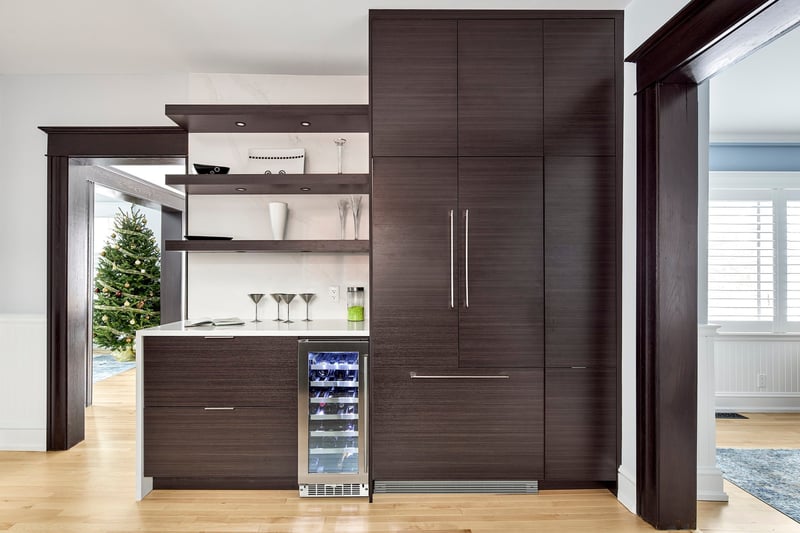
Wide variety: While they’re most commonly used to replicate various wood grains, textured melamine cabinets come in solid colours and other designs. In fact, most manufacturers will carry hundreds of different melamine selections from which to choose.
Affordable: Standard melamine is significantly more cost-effective than premium selections like painted MDF or natural wood cabinets.
Durability: Melamine is one of the most durable cabinet materials on the market today, noted for its strong resistance to excessive moisture, heat, and stains.
Cons:
Chipped corners: While regular textured melamine is still a durable product, issues can arise. The corners, for example, can be somewhat prone to chipping.
Limited door styles: Melamine will almost always come in a slab (flat) door style. Some manufacturers may offer 5-piece doors, but they are relatively few and far between, and the quality of the product is extremely lacking compared to MDF or natural wood 5-piece doors.
European Textured Melamine (ETM)
Pros:
Higher quality: European textured melamine is considered a higher quality, luxury line of melamine. ETM produces a prestige material with deeper textures and colours, and a more realistic-looking wood grain.
More convincing texture: In contrast with standard textured melamine, ETM does not feel as “plasticky” and is a more convincing imitation of how natural wood feels.
Thicker: Although textured melamine and ETM are quite similar to one another, ETM is thicker and holds up better to everyday bumps and damage.
Less chipping: The chipped corners of textured melamine won’t be an issue for high-quality ETM products.
Cons:
Price: As a higher-end product, European Textured Melamine cabinets also come with an increased price tag.
Metal Frame Cabinet Doors
Pros:
Durable: It is a durable material that doesn’t scratch too easily—especially on something like a matte black finish. You also don’t need to worry about moisture, heat, or humidity.
Perfect for glass doors: They have the opportunity to get creative with the variety of glass inserts available. There’s standard, leaded (crystal), acid wash, mirror, or frosted glass, and even jet black, to name a few. You can even go glassless and have the metal frames on their own.
Cons:
Limited Design: Metal cabinet doors aren’t the most flexible when it comes to styles and are only available as flat doors with no design or routering. Their colours are also extremely limited, with most manufacturers only carrying a variety of black, grey, and stainless steel.
Price: Metal cabinet doors can be quite expensive when accompanied by glass inserts, as well as a finished cabinet interior and lighting.
Design with Deslaurier Custom Cabinets
If you’re looking for the perfect custom cabinets for your kitchen, Deslaurier Custom Cabinets has everything you need!
Deslaurier proudly carries every material listed above in our product catalogue, and we believe we have a cabinet selection that will fit any budget and design style!
Book a consultation today with a Deslaurier design expert at our Ottawa Showroom or schedule a virtual meeting!
With over 40 years of experience to our name, we provide our clients with a fully customized design process with our talented team of designers.
Interested in becoming an authorized Deslaurier dealer? Visit our Become a Dealer page to learn more! Live outside the area? Visit our Find a Dealer page to connect with a Deslaurier dealer near you!


